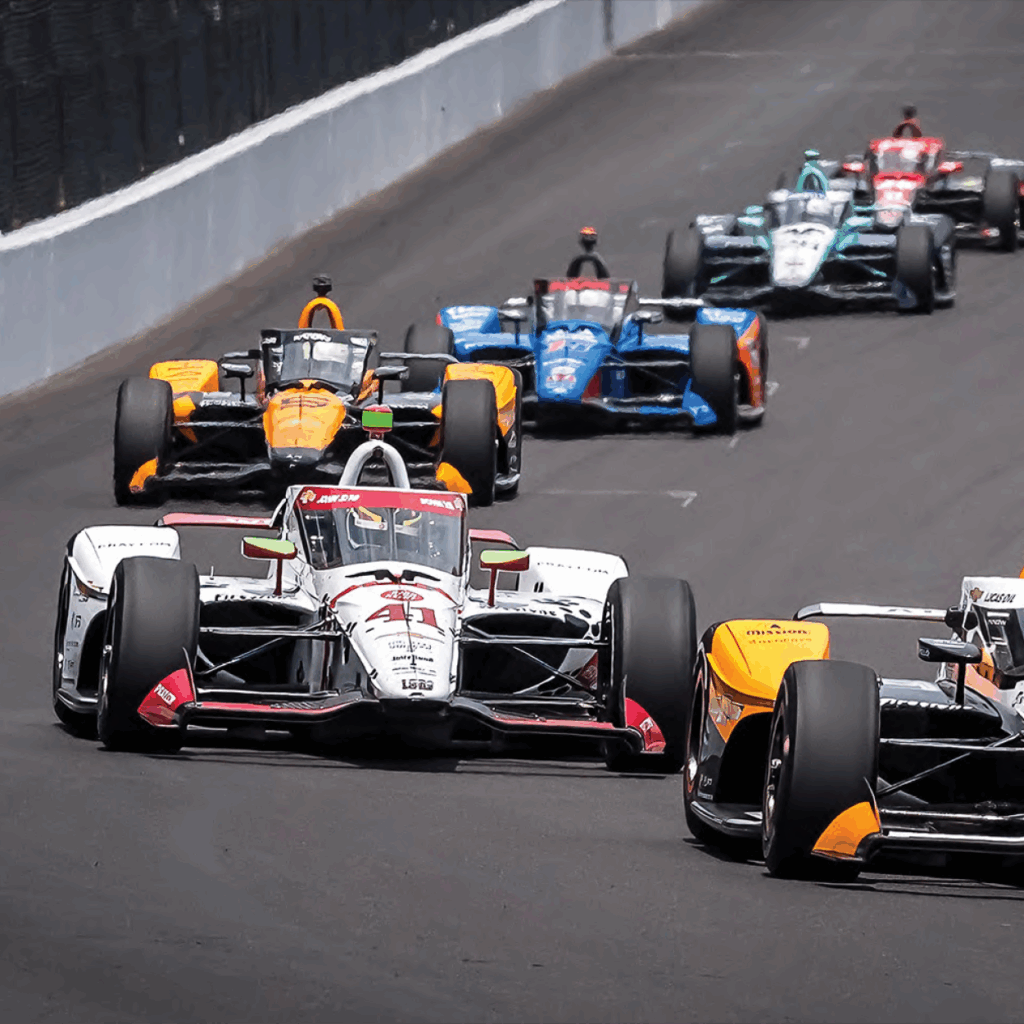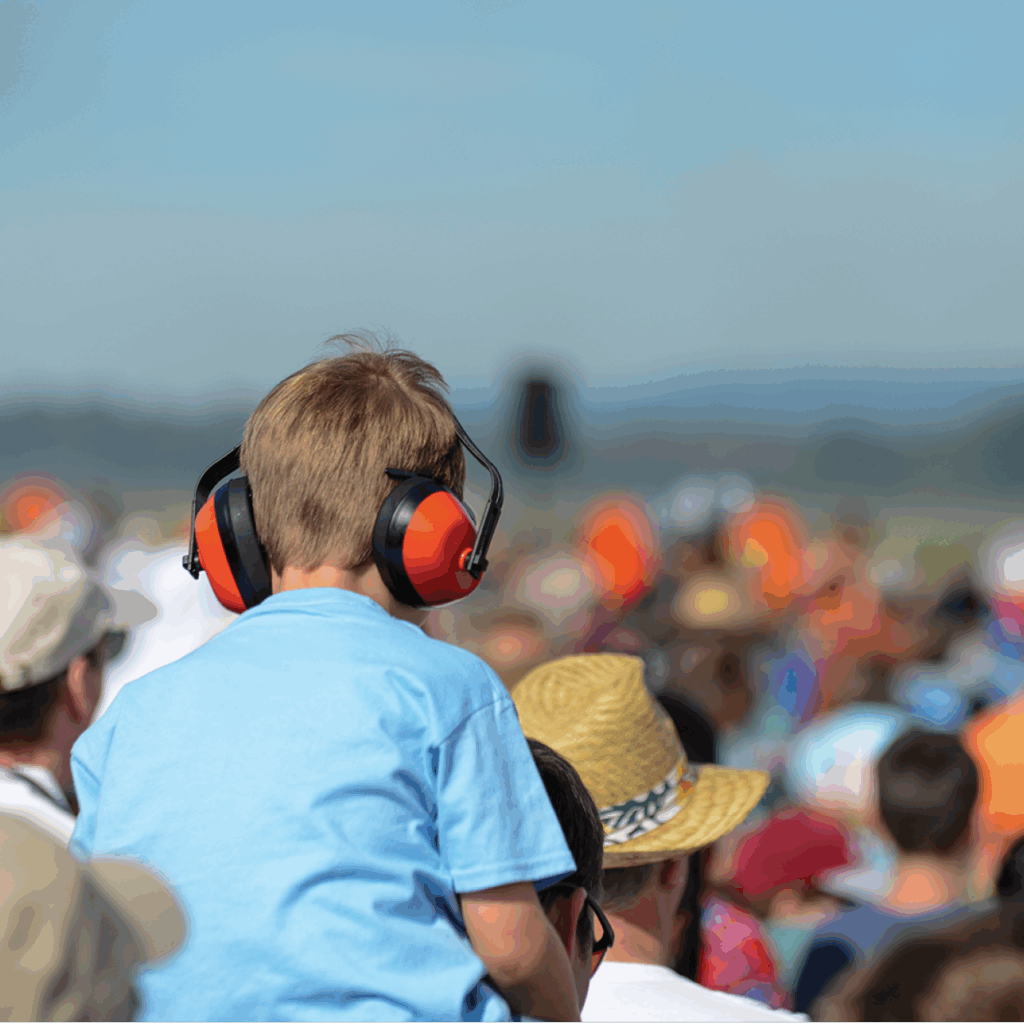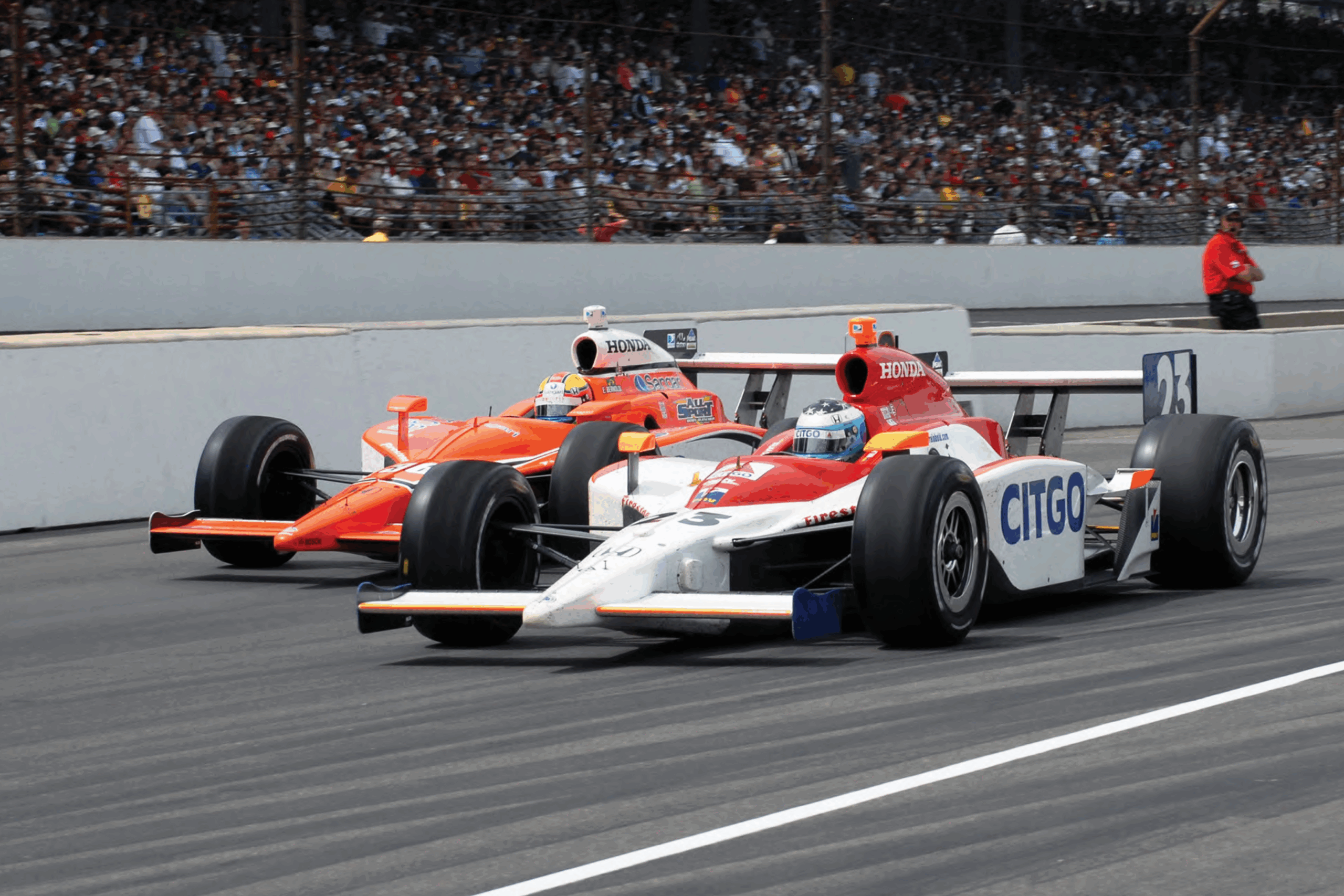This article was written by Suzanne O’Connor, Au.D., a HearingLoss.com®-Certified provider located at Professional Hearing Services in Indianapolis, Indiana.
The rumble of the engines, the cheer of the crowd, the thrill of speed — the Indy 500 is an unforgettable experience. As the “Greatest Spectacle in Racing,” this legendary event draws fans from around the globe, eager to witness the power and precision of IndyCars as they zoom around the iconic track at breakneck speeds. But amidst the excitement, it’s crucial to protect your hearing while soaking in the action. It’s easy to get swept up in the excitement, but just as you’d pack sunscreen for a sunny race day, ear protection should be on every fan’s checklist. Noise-induced hearing loss is one of the most preventable – and unfortunately, one of the most overlooked – health risks at large sporting events.
Race-day noise levels can reach staggering heights. A typical IndyCar engine revs up to around 140 decibels – that’s equivalent to standing next to a jet engine at takeoff. Prolonged exposure to sounds over 85 decibels can cause permanent hearing damage, making ear protection essential. Whether you’re a first-timer or a seasoned racegoer, taking proactive steps to protect your ears can ensure you enjoy the race without risking your long-term hearing health.
Why Protecting Your Hearing at the Indy 500 Matters

Human hearing is remarkably sensitive. Our ears are designed to pick up subtle sounds — from the rustling of leaves to the soft purr of an engine. But when sound levels exceed 85 decibels, the delicate hair cells in our inner ear begin to sustain damage. At 140 decibels, the noise from an IndyCar can cause instant, irreversible harm.
For comparison, here are some everyday sounds and their decibel levels:
- Gunshot: 140 – 170 dBA
- Jet engine: 130 – 140 dBA
- Emergency vehicle siren: 120 – 125 dBA
- Rock concert: 110 – 120 dBA
- Motorcycle: 90 – 110 dBA
- Riding lawn mower: 90 – 100 dBA
- Power lawn equipment: 75 – 100 dBA
- Vacuum cleaners: 65 – 85 dBA
- Dishwashers: 40 – 60 dBA
As you can see, the noise at the Indy 500 far surpasses these everyday sounds, making hearing protection a must. What makes these levels even more concerning is the cumulative impact of noise exposure. Even if you’re not sitting trackside for the entire race, repeated bursts of engine noise over several hours can still cause long-term damage. And unlike other injuries, hearing damage is often painless and gradual – you may not notice until it’s too late.
Make Hearing Protection Part of Your Race-Day Prep
It’s easy to forget hearing protection when planning your day at the Indianapolis Motor Speedway – but protecting your ears is just as important as wearing sunscreen or staying hydrated. Since noise-induced hearing loss is permanent, a little planning can go a long way toward keeping your hearing safe.
Use Custom Hearing Protection for a Personalized, Powerful Fit
If you’re looking for the most comfortable and effective option, consider visiting an audiologist to order custom hearing protection. Ideally, schedule your appointment at least two weeks before race day to allow time for the process. Your audiologist will take impressions of your ears and help you choose the features that matter most, whether that’s color preferences, a lanyard to keep them handy, or even filters to maintain sound clarity while lowering volume.
The result? A secure, personalized fit designed to give you maximum protection at the 500 and beyond.

Race-Day Ready Starts with Your Ears
Heading to the Indy 500? Make custom ear protection part of your race-day prep. Schedule your appointment with a certified audiologist now to ensure your personalized hearing protection is ready before the engines roar.
How to Use Foam Earplugs for Maximum Protection
Over-the-counter foam earplugs are a dependable and widely available option – and some of the most recognizable ones, often bright yellow and cylindrical, have even been manufactured on the west side of Indianapolis for decades. No matter which brand you choose, the real difference in protection comes down to how you wear them.
To get the full benefit, follow these simple steps:
- Roll the earplug between your fingers lengthwise, compressing it into the tightest, narrowest cylinder you can.
- Insert the plug deeply into your ear canal – not just the outer part of your ear.
- Hold your finger gently over the entrance of your ear for at least two minutes while the foam expands and forms a tight seal.
- Release and repeat the process for your other ear.
When both earplugs are inserted properly, you should hear a noticeable reduction in the sounds around you – the crowd will still be there, but the harsh roar of the engines will be dramatically muted. If not, try again for a better seal.
If you glance around at the track, you’ll likely see many fans wearing earplugs incorrectly – or not at all. Sharing what you’ve learned here could help someone else protect their hearing. Because sometimes, the best traditions aren’t just loud – they’re smart, too.
Preparing for Race Day with Hearing Aids
If you use hearing aids, preparation is key to enjoying the race without compromising your hearing health. Here are some tips to keep your hearing aids secure and your ears protected:
1. Use Ear Protection
Invest in high-quality earplugs or noise-canceling earmuffs. Custom earplugs offer a snug fit and can reduce harmful noise levels while still letting you enjoy the crowd and track announcer. Over-the-counter foam earplugs are another great option and can be found at most pharmacies or hearing clinics. For added protection, consider wearing earmuffs over your earplugs.
2. Secure Your Hearing Aids
The excitement of the race means a lot of movement – from jumping up to cheer to navigating crowded grandstands. Sports clips attach to your clothing, ensuring your hearing aids stay put even when the crowd goes wild. Protective covers help shield them from dust and moisture, keeping them clean and functional throughout the day.
3. Consider Adjustments
Consider asking your audiologist to prescribe a “mute” program to temporarily mute your hearing devices or a separate program to be worn in high-noise situations like at the track. If your hearing aids are paired to your smartphone, you may be able to make some adjustments yourself – a handy feature amidst the roar of the engines!
4. Take Breaks
Give your ears some quiet time by stepping away from the track periodically. Even short breaks can reduce your risk of hearing damage. Take advantage of quieter areas outside of the stands or suites, like the food courts, merchandise tents, or family zones, to give your ears a rest.
Enjoying the Race with Confidence
With the right preparation, you can fully embrace the excitement of the Indy 500 while protecting your hearing. Beyond using hearing protection, consider these additional tips for making the most of your race-day experience:
- Arrive Early: Beat the crowds and enjoy the prerace activities infield before the engines rev up. When purchasing Indy 500 tickets, consider that higher seats are generally quieter than those closer to the track.
- Stay Hydrated: The excitement of the race, combined with the heat and noise, can be draining. Drink plenty of water to stay refreshed and alert.
- Connect With Other Fans: The Indy 500 community is passionate and welcoming. Don’t hesitate to strike up conversations with fellow racegoers – you might pick up some insider tips and make lasting connections.
Protecting Future Generations

Attending the Indy 500 is often a family affair, with fans passing down their love of racing through generations. If you’re bringing kids along, it’s even more important to protect their developing ears. Invest in child-sized earmuffs, which offer a comfortable fit and optimal noise reduction.
Teaching young race fans about hearing protection early on instills good habits that can last a lifetime. Lead by example – wear your ear protection proudly and encourage those around you to do the same.
For those who think hearing loss is something to worry about “later,” taking a few simple steps today can prevent lifelong issues down the road. Protecting your hearing isn’t about admitting weakness – it’s about embracing the future with all senses intact.
A Lasting Memory, Not Lasting Hearing Damage
The Indy 500 is a sensory overload in the best way possible. The sights, the sounds, the adrenaline – it all combines to create an experience like no other. By taking the right precautions, you can ensure that the memories you make at the track are ones you’ll cherish for years to come, without sacrificing your hearing health.
Remember: Protecting your hearing doesn’t mean dulling the experience. It means preserving it. Whether you’re a die-hard racing fan or a first-timer, embracing hearing protection is a smart move that lets you enjoy the thrill of the race while safeguarding your ears.
So, gear up, pack your ear protection, and get ready for an unforgettable ride. The engines are roaring, the green flag is waving, and with these tips, you’ll be able to enjoy every heart-pounding moment safely.
How HearingLoss.com Can Help – From One Indy 500 Fan to Another
As an audiologist based in Indianapolis, I’ve seen firsthand how loud environments like the Indy 500 can take a toll on your hearing. But I’ve also seen how simple steps – like using proper ear protection or fine-tuning hearing aids – can make all the difference in keeping the experience safe and enjoyable.
That’s why I’m proud to be part of the HearingLoss.com network. This platform brings together providers who are deeply committed to delivering care that’s not just clinically sound but also personal, practical, and patient-first. I joined the network because it reflects the way I believe hearing care should be delivered – with expertise, compassion, and a focus on helping people live life to the fullest.
Whether you’re prepping for race day, managing hearing aids in noisy environments, or just starting to explore your hearing health, HearingLoss.com is here to support you. You’ll find certified providers who follow the highest standards in clinical and patient care – professionals who will listen, personalize your experience, and guide you through important decisions like choosing the right hearing protection or optimizing your hearing aids for loud environments like the speedway.
Already using hearing aids? A certified provider can fine-tune your settings for loud environments, offer accessories to secure and maintain your devices, and help you build a care plan so you’re race-day ready.
If you’re not sure where to begin, start with the free online hearing screener or browse expert-backed resources. Using HearingLoss.com makes it easy to take control of your hearing health – before, during, and long after the checkered flag waves.
For over 40 years, Professional Hearing Services has been known for our clinical expertise and personal approach; we are the area’s most established audiology private practice. Owned and operated by a Doctor of Audiology, we offer premier service guided by best practices, which means we only use the latest technology. We provide comfortable surroundings, courteous service, and thorough follow-up care with a lasting commitment to your satisfaction. Our patients can expect premium care and improved quality of life. Schedule an appointment at our practice in Indianapolis, Indiana, or search for a certified hearing care professional in your area and browse through additional resources, including a free online hearing screener.


